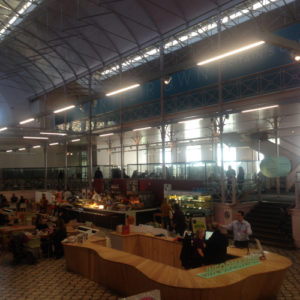 Nestled away in Bethnal Green, amongst the cat café’s and vintage shops, is the V&A Childhood Museum, and if you’re looking for a gushing love affair towards a museum and their practice, look no further. Here are my thoughts towards the V&A Childhood Museum, and why I have a lot of love for it.
Nestled away in Bethnal Green, amongst the cat café’s and vintage shops, is the V&A Childhood Museum, and if you’re looking for a gushing love affair towards a museum and their practice, look no further. Here are my thoughts towards the V&A Childhood Museum, and why I have a lot of love for it.
When planning my visit, I wasn’t expecting to love it as much as I did. If I’m honest, I was expecting a museum for children, rather than a museum about childhood. One of those museums where everything is just an interactive, everything is a child friendly interpretation. However, I was not disappointed. The museum was balanced perfectly. I found there to be just enough for children to enjoy, and just enough for adults to enjoy and take value from.
 What struck me when exploring the galleries was the, assumedly intentional, lack of explicit mention of gender. Of course, there were “girls” toys and there were “boys” toys, but as best as I can remember, they were not referred to as so. The gendering of toys is a debate had in many mediums over the past few years, and has perhaps influenced the interpretations. Projects such as Let Toys Be Toys and stores responding to customer complaints, it was great to see the museum following suit. Children are heavily influenced by what they see, and seeing a museum showing “girls” and “boys” toys categorised as so, would only teach stereotyped gender roles.
What struck me when exploring the galleries was the, assumedly intentional, lack of explicit mention of gender. Of course, there were “girls” toys and there were “boys” toys, but as best as I can remember, they were not referred to as so. The gendering of toys is a debate had in many mediums over the past few years, and has perhaps influenced the interpretations. Projects such as Let Toys Be Toys and stores responding to customer complaints, it was great to see the museum following suit. Children are heavily influenced by what they see, and seeing a museum showing “girls” and “boys” toys categorised as so, would only teach stereotyped gender roles.
The museum was light, and airy, with a clear yet unimposing route around the galleries. Galleries that explore culture, society throughout history, how childhood has been perceived within those histories, and of course a pretty vast collection of toys.
 One thing that struck me about the V&A Childhood Museum was the transparency of why they collect what they do, particularly with the collection of contemporary objects. They had a display case, in which showed a costume dress from Frozen, and a children’s desk with a modern design. In the case, the interpretation panel reads,
One thing that struck me about the V&A Childhood Museum was the transparency of why they collect what they do, particularly with the collection of contemporary objects. They had a display case, in which showed a costume dress from Frozen, and a children’s desk with a modern design. In the case, the interpretation panel reads,
The museum has a collecting policy that identifies and prioritises what it will collect. This focuses on significant objects to fill gaps in the collection and those with interesting stories that represent different aspects of childhood throughout history.
 As a Museum Studies student and all round museum geek, the hows and whys of museum collecting practice are something I know of. Yet, it got me thinking about the general perception of museum collecting, and whether the majority of the visitor public would know, or have interest in, collecting practice. Perhaps not, yet the transparency of practice, even the public explanation of collection practice at all, was not something I’ve seen in a museum before and I utterly admired the sentiment.
As a Museum Studies student and all round museum geek, the hows and whys of museum collecting practice are something I know of. Yet, it got me thinking about the general perception of museum collecting, and whether the majority of the visitor public would know, or have interest in, collecting practice. Perhaps not, yet the transparency of practice, even the public explanation of collection practice at all, was not something I’ve seen in a museum before and I utterly admired the sentiment.
-Chloe Turner
Junior Girl
Girl Museum Inc.
